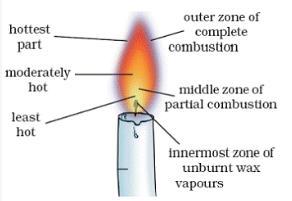What is flame? Describe different zones of the flame.
Flame
A flame is a region where combustion or burning of gaseous substances takes place by the evolution of heat and light.

Variously heated Parts of a Candle flame
Zone of non-combustion or the inner zone
This is the dark zone that lies around the wick of the candle. It is the innermost zone of the flame. This zone contains unburnt vapours of wax. As there is no air available in this zone, no combustion takes place. Therefore, it is the least hot part of the flame.
Zone of incomplete combustion or the luminous middle zone
The middle zone is the brightest zone of the flame. In this zone, there is an inadequate supply of air. Therefore, there is incomplete combustion of wax vapours, resulting in the formation of carbon monoxide and unburnt carbon particles. These unburnt carbon particles glow and produce a yellow flame. This zone is moderately hot.
Zone of complete combustion or the non-luminous zone
The outermost zone of the flame is called as the zone of complete combustion. In this zone, complete combustion of wax vapours takes place, forming carbon dioxide and water vapour. This is the hottest zone of the flame. It is also referred to as the non-luminous zone.
Blue zone
At the bottom of the flame lies a blue zone. The blue colour is due to the burning of carbon monoxide produced in the zone of incomplete combustion of carbon.